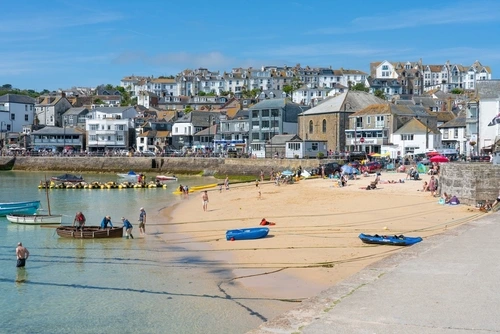
Rightmove’s Happy at Home study revealed where people in the UK think is the happiest place to live. The survey, based on 21,000 answers, takes a few factors into consideration.

For instance, whether or not there is a real sense of community spirit in the local area, whether people are friendly and polite; how many sports, cultural and recreational activities there are; or if the essential local services like doctors and schools are efficient.
The overall number one spot in the list belongs to St Ives, in Cornwall, which has been nominated the happiest place to live in the UK by its residents, as there is a great community spirit and the residents all have a strong sense of belonging. The second and third positions go, respectively, to Galashiels in Scotland and Woodbridge in Suffolk.
The happiest places in the UK
In the order established by Rightmove’s survey, here are the top ten happiest places to live in the UK:
- St Ives, Cornwall
- Galashiels, Scotland
- Woodbridge, Suffolk
- Hexham, Northumberland
- Perth, Scotland
- Harrogate, Yorkshire
- Anglesey, Wales
- Bury St Edmunds, Suffolk
- Stirling, Scotland
- Cirencester, Gloucestershire
Galashiels’ residents in Scotland highlighted how friendly and polite people are there.
Woodbridge, a market town located in Suffolk, is in third position. The Suffolk area also sees its own Bury St Edmunds taking up the eighth spot on the list.
When it comes to Wales, Anglesey is considered the happiest place to live, and it is also the only Welsh city in the national top ten.
Harrogate, taking up the sixth place, has great rail links to neighbouring cities and also many restaurants and amenities. In addition, it is also one of the most affluent cities in the UK, with a high percentage of higher earners living in the city.
In London, on the other hand, Richmond upon Thames gets the crown for the eighth year straight as the region’s happiest place to live. In particular, its strengths are easy access to sports and recreational activities, alongside the high number of green spaces.
What makes for a happy town?
Rightmove told City Monitor, “a sense of belonging in an area is the number one factor which contributes to someone feeling happy where they live”.
Even if a place can’t necessarily make someone happy on its own, the sense of belonging plays an important role in everyone’s personal experiences and well-being. Strong social networks, neighbourliness and a varied choice of activities also constitute elements to keep in mind in “happy” places.
Paul Gibbens, a property expert and marketing manager at Housebuyers4u, also suggested that good transportation links and the safety of the area also contribute to how happy a town is. He added that “the nearest pub” is often a dealbreaker too.
The survey focused on ten different happiness factors, such as the presence and access to green spaces and the friendliness of residents.
To be specific, these were:
- Community spirit
- Sense of belonging
- One can be themselves
- People are friendly
- Sports and recreational activities
- Artistic and cultural activities
- Skill-developing opportunities
- Nature and green spaces
- Essential services
- Non-essential services like restaurants
Some factors have to do with the kind of property itself, whether it has a garden and how affordable it is. Some 29% of buyers stated that the absence of a garden is a deal-breaker when looking to purchase a property.
Gibbens told City Monitor: “Generally speaking, it seems that people tend to be happier in areas where house prices are higher. No doubt good old word of mouth attracts more people too.”
When it comes to affordability, on the other hand, 22% of renters said that the main reason to move is to get better value for money, and 11% of them wanted to reduce energy costs.
Property in the happiest places
The Rightmove survey also revealed that many coastal areas like St Ives have seen an abundance of people interested in purchasing a house there. The number of enquiries to buy a house in Cornwall was 9% higher in 2022 than in 2019.
This has also led the average price of properties in the area to rise significantly to £523,731 in 2022, a 6% rise, compared with £492,870 in 2021. These numbers are also higher than the national average asking price, which is £290,000.
In St Ives particularly, house prices have gone up too. Gibbens informed City Monitor that HouseBuyers4U figures “represent a rise of 15.8% over the last 12 months for sold prices in the area”.
The city in second position, Galashiels sees significantly lower prices overall, showing that property prices don’t always correlate with happy residents, even though they are still higher than in 2019 and 2020.
Over 2022, properties in Galashiels sold for an average of £150,937, which is 5% higher than 2021 numbers. The highest peak this Scottish town saw was in 2010, when house prices reached £655,295.
The third-positioned Woodbridge’s average house prices have increased by 3% in the past year, reaching an average of £441,343. The majority of properties sold, furthermore, are detached with an average price of £701,531.
[Read more: Competition for rental properties in the US sees rebound in New York and Silicon Valley]






